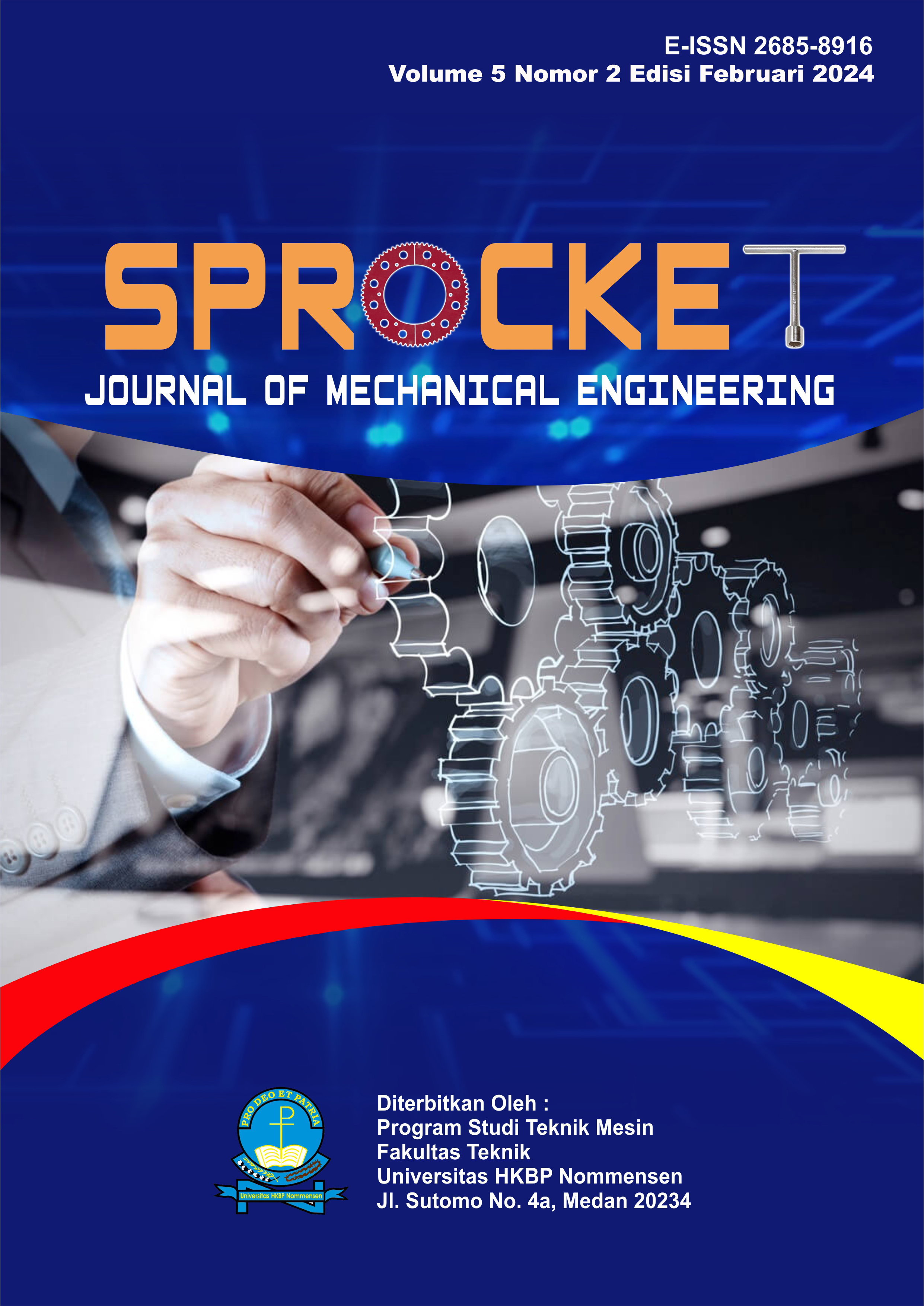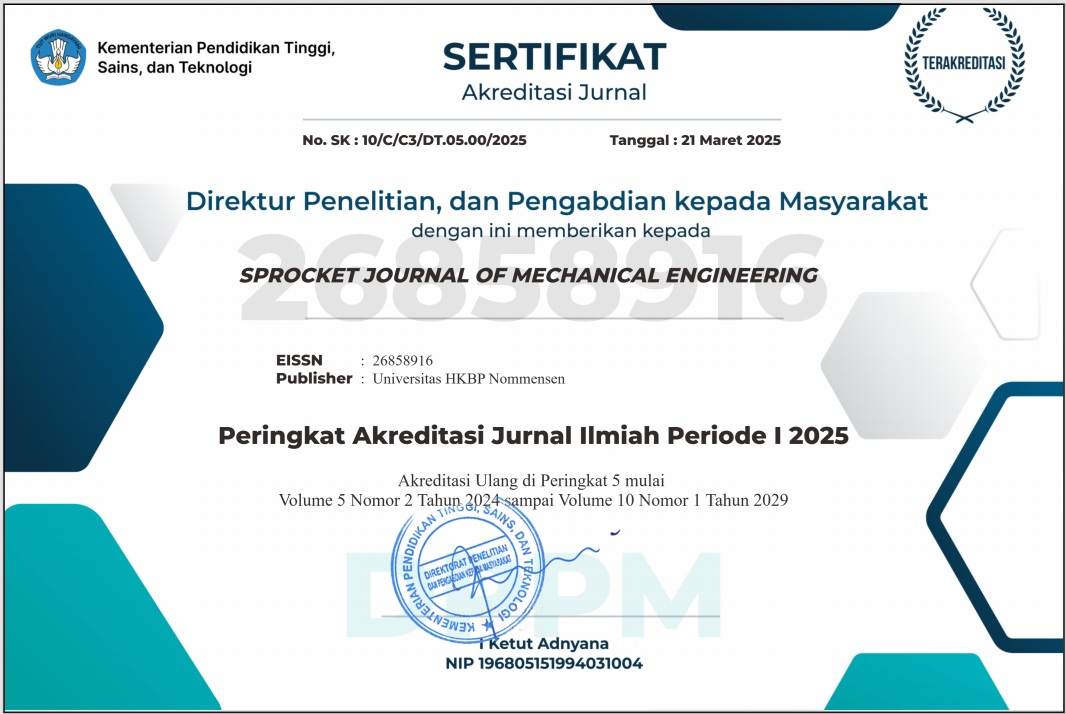Perencanaan Daya Dan Perbedaan Jenis Bantalan (Bearing) Pada Mesin Pengupas Kulit Kacang Tanah Kapasitas 60 Kg/Jam
Abstract
Appropriate technology is technology that is right on target to be used and developed by the community. The development of technology aims to ease human work. The Indonesian state, with the majority of its population working as farmers, really needs appropriate technological innovation to increase agricultural productivity. In this case, the author highlights the low productivity of peanut farmers in Indonesia. On the other hand, the level of peanut demand is increasing from year to year, but consumer demand cannot be met due to low domestic peanut production. Therefore, this study aims to determine the power and bearing maintenance on peanut shell peeling machines using an electric motor, which uses a Tachometer measuring instrument and is carried out at the Production Laboratory of HKBP Nommensen University Medan located at JL. Sutomo No. 4 Medan. The peanut shell peeling machine is made horizontally with 1 shaft and 40 peeling rods transmitted by a V-belt and pulley using an electric motor that functions to peel peanuts to separate the seeds from the shell. By designing and designing a peanut shell peeling machine, the bearing life used in the peanut peeler machine is 3440.78 and 909.86 hours at a rotation speed of 1382 rpm and 58623.94 and 20877.55 hours at a rotation speed of 795.7 rpm. The faster the engine speed, the enumeration load received by the bearing will be lighter, the slower the engine speed, the heavier the enumeration load received by the bearing. The production capacity that can be produced by this peanut shell peeling machine is 60 kg / hour with a peeling force of 51,012 and AC motor power of 1 Hp with a rotation of 2930 rpm.
References
[2] B. Winarso, “Kebijakan pengembangan komoditas tanaman pangan dalam mendukung program master plan percepatan dan perluasan pembangunan ekonomi Indonesia (MP3EI) studi kasus di Propinsi Gorontalo,” J. Penelit. Pertan. Terap., vol. 13, no. 2, 2013.
[3] S. Hariyadi and D. M. Purnama, “Perencanaan Mesin Pemilah Dan Pengupas Kulit Kacang Tanah Dengan Corong Screen Berkapasitas 150 Kg/Jam,” Wahana Tek., vol. 7, no. 2, pp. 143–163, 2018.
[4] A. Sutejo and A. R. Prayoga, “Rancang Bangun Alat Pengupas Kulit Ari Kacang Tanah (Arachis hypogaea) Tipe Engkol,” J. Keteknikan Pertan., vol. 26, no. 2, 2012.
[5] I. Muhammad, “Rancang Bangun Alat Pengupas Kulit Ari Kacang Tanah Untuk Pembuatan Kacang Asin Menggunakan Motor Listrik,” 2020.
[6] I. Ferdiansyah, B. Wiryono, and K. Karyanik, “Analisis Performansi Mesin Pengupas Kacang Tanah Terhadap Diameter Polong Kacang Tanah Menggunakan Penggerak Motor Listrik,” Protech Biosyst. J., vol. 2, no. 2, pp. 65–74, 2022.
[7] R. Tahapali, R. Djafar, and Y. Djamalu, “Modifikasi Mesin Pengupas Kulit Kacang Tanah,” J. Teknol. Pertan. Gorontalo JTPG, vol. 4, no. 2, pp. 78–82, 2019.
[8] J. HUTAHAEAN, “ANALISA HASIL PENGUPASAN KULIT KACANG TANAH DENGAN MENGGUNAKAN MESIN MODEL IMPACT ROTARY,” 2023.
[9] R. T. Tampaty, “PERANCANGAN MESIN PENGUPAS KULIT KACANG TANAH BERKAPASITAS 20 KG/JAM,” presented at the Prosiding SoBAT (Seminar Sosial Politik, Bisnis, Akuntansi dan Teknik) Universitas Sangga Buana YPKP, LPPM Universitas Sangga Buana YPKP, 2019, pp. 300–310.
[10] R. C. Hibbeler, Engineering mechanics: dynamics. Pearson Educación, 2004.
[11] A. D. Deutschman, W. J. Michels, and C. E. Wilson, “Machine design: theory and practice,” No Title, 1975.
[12] N. L. Antara, “Organic Waste Chopper Tool Design Using Autodesk Inventor 2015 Software,” Log. J. Ranc. Bangun Dan Teknol., vol. 19, no. 2, pp. 68–77, 2019.

This work is licensed under a Creative Commons Attribution 4.0 International License.
Penulis yang menerbitkan dengan SPROCKET JOURNAL OF MECHANICAL ENGINEERING menyetujui ketentuan berikut :
- Penulis memegang hak cipta dan memberikan jurnal hak penerbitan pertama dengan karya yang dilisensikan secara bersamaan di bawah Lisensi Internasional Creative Commons Atribusi 4.0 . yang memungkinkan orang lain untuk berbagi karya tersebut dengan pengakuan atas kepengarangan karya dan penerbitan awal dalam jurnal ini.
- Penulis dapat membuat pengaturan kontraktual tambahan yang terpisah untuk distribusi non-eksklusif atas versi jurnal yang diterbitkan dari suatu karya (misalnya, mempostingnya ke repositori institusional atau menerbitkannya dalam sebuah buku), dengan pengakuan atas penerbitan awalnya di jurnal ini.
- Penulis diizinkan dan didorong untuk mengunggah karya mereka secara daring (misalnya, di repositori institusi atau di situs web mereka) sebelum dan selama proses penyerahan, karena hal ini dapat mengarah pada pertukaran yang produktif, serta kutipan yang lebih awal dan lebih banyak dari karya yang diterbitkan (Lihat Pengaruh Akses Terbuka ).






.png)
.png)

